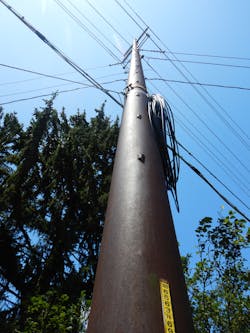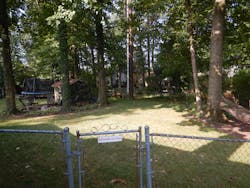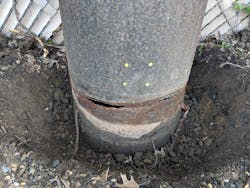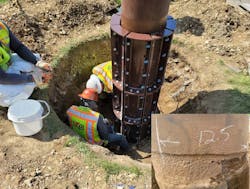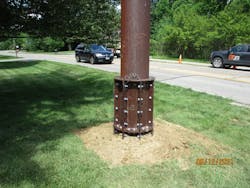Giving Old Steel Poles New Life
Safe and reliable electricity has been the cornerstone of our modern society for the last century. While large portions of the general public may take this essential commodity for granted, utility professionals know just how much effort and resource goes into keeping the lights on when it matters most. Between the ongoing fires out West, the annual hurricanes impacting the Gulf and Atlantic Coasts, and the severe winter weather in Texas, the topic of grid resiliency is being forced into the spotlight now more than ever. Properly inspecting and maintaining these critical infrastructure assets has become an important and strategic element of improving structural reliability and grid resilience.
Westerville Electric, a public power provider that serves the City of Westerville, a suburb of Columbus Ohio, recently completed a life-extension project on its 69-kV transmission line that illustrates well the challenges, solutions, and outcomes of a proactive inspection and maintenance mindset. The transmission line was built back in the early 1970s in the open fields of Ohio and received little attention structurally over decades of service.
Pioneering Technology
It was one of the first lines in the country to employ poles built from self-weathering steel, or “Cor-Ten” as it was commonly referred to, which were manufactured by Union Metal Manufacturing Company. At the time the poles were installed, weathering steel was thought to be a “maintenance free” material, but as we know now, there is no such thing as a “maintenance free” pole or tower. For the first four decades of the line’s existence, the extent of the maintenance performed was strictly overhead. The largest up-grade or restoration project undertaken was a ceramic to polymer insulator upgrade that
was completed 15 years ago.
But that all changed in 2018 when a “crack” was discovered in one of the poles adjacent to a well-traveled jogging trail which cut through town. That crack turned out to be pack-out rust, a type of corrosion phenomena that occurs due to atmospheric conditions within restricted spaces such as crevices. This damage had occurred near groundline, where conditions made it difficult for the “self-weathering” patina to thoroughly dry out between wet cycles to protect the pole from continued corrosion, a condition critical to establish the airtight layer of material that protects the underlying steel wall thickness. Coincidentally, the groundline is also where the pole experiences maximum stress, and therefore represents an area of great risk to the structure.
A Need for Action
Westerville’s technical team recognized quickly that the structural integrity of the pole was compromised due to unexpected and previously undetected corrosion, and that swift action would be necessary. With a large portion of the line now being located among the residents of the town, in many cases in people’s back yards, the risk of a potential pole failure was unacceptable. Unfortunately, there was little existing corrosion data available to make any appropriate decisions. More information would be required to help guide them to the most optimal path forward.
The engineering team at Westerville engaged Matergenics to conduct a corrosion assessment of the remaining 109 steel poles to better understand the scale of the problem. Since most corrosion of steel poles occurs right at or below the groundline, the damage can be hidden or disguised and go unnoticed for many years. Currently the best way to diagnose corrosion and its structural impact on a steel pole or tower is to excavate the ground around the asset to an appropriate depth that exposes the material for a hands-on, visual and NDT (nondestructive testing) inspection. Severe degradation that significantly reduces the wall thickness of the shaft can then be measured accurately. From there the remaining load capacity of the pole and its current strength in relation to the original design capacity can be evaluated.
In addition to the inspection of the pole itself, Westerville also conducted a corrosivity assessment of the surrounding soils to better understand the impact the environment was having on their structures. This would prove to be a key piece of data that would help shape future corrosion mitigation and restoration strategies moving forward. Ultimately, the corrosion assessment program was completed in June of 2019 and brought to light the true nature and extent of the problem. In total, 70 of the 109 poles required some level of intervention, ranging from coatings treatment to structural restoration or full structure replacement.
Initial Challenges
Westerville had already begun the repair process of the initial pole next to the jogging trail before the remaining ground line inspections had even started. The priority was to stabilize the structure and prevent any future failures from posing serious risk to pedestrians or vehicular traffic in the area. The most straightforward and seemingly cost-effective solution would be to engage a local service provider that could engineer and execute a repair involving the welding of a reinforcing steel plate to the pole shaft. This would effectively replace any wall loss due to corrosion and restore the pole’s structural capacity. This approach, faced many unanticipated hurdles. First, there were no local firms with the expertise to offer a turnkey solution that included both the engineering and field service elements of the project. As a result, Westerville hired and managed multiple subcontractors to perform each of the various stages of the repair including structural engineering, weld procedure development and qualification, field welding, and non-destructive testing to ensure the final repair was acceptable.
The ultimate goal of restoring the steel pole was successful, but this method proved costly and cumbersome. The internal effort needed to manage the contractors proved to be an overwhelming task for the already busy Westerville team. The cycle time from start to finish took almost six months because of the precise dimensions and fit up preparation needed for this type of steel collar repair. To make matters worse, it was determined that most of the affected structures were all different designs with varying geometry, meaning a “one size fits all” welded collar solution would not apply. Each pole would require a custom fit solution. Now, with the proposition of 70 additional poles requiring attention, a multi month, custom fit project per asset simply wasn’t scalable. A new solution was needed.
In addition to the logistical challenges of the repair work on the original pole, the poles flagged during inspection for immediate replacement introduced a whole separate list of constraints to contend with. When Westerville first constructed this line 40+ years ago, much of the area had not been fully developed. Most of the line now cuts though residential neighborhoods and commercial properties. The task of positioning and operating heavy construction equipment in a resident’s backyard to support full pole replacement, and then restoring the property back to its original state following the work would be expensive, both in terms of real cost as well as goodwill with the residents and the community as a whole. A less intrusive option would be much more palatable for the utility and the landowners. Westerville engaged with multiple firms over the next 12 months to discuss and explore various restoration options, but still had not arrived on a solution to address the most structurally deficient poles which would satisfy all of their critical objectives.
Life Extension Solutions
In September of 2020, the Westerville engineering team was referred to Exo, a structural engineering and field services firm out of Texas that had experience with restoration of transmission poles and towers. Exo had recently completed a temporary pole stabilization project on some severely corroded galvanized poles along the Florida coast using a type of modular load transfer bracket, or splint. The splint solution was equally robust as it was flexible. A series of interlocking and prefabricated channels that when bolted together would from a gusseted collar around the pole, the splint was adjustable and could form to poles with a range of diameters, tapers, and even ground sleeves. Combined with a barrier protective coating on the pole/components and cathodic protection in some cases, the splint offered corrosion mitigation, prevention, and full structural capacity restoration.
After learning about the specific objectives Westerville was hoping to achieve in a turnkey, flexible, non-invasive solution that would restore the steel poles to its designed strength and considerably extend the life of the asset, Exo engineers felt confident this would be a perfect scenario to use the pole splint solution. The installed cost of the splint made the option even more attractive, coming in at roughly a third of the cost to fully replace the poles, and with far less disturbance to the neighbors. The value proposition of this alternative seemed to check all of boxes for the utility. The project was promptly approved by the city council in January and work began shortly thereafter to design and fabricate the splints, with hopes of completing all installation by the Summer of 2021.
In total, 29 poles had suffered significant wall loss due to corrosion, which would require splints. The majority of these structures were located either along well traveled roads or in the back yards of Westerville residents. While the process of installing this equipment was much less intrusive than full pole replacements, this field work still presented some significant challenges. In order to install the brackets to the pole shaft in the correct position, significant excavation around the pole base was required. Depending on the depth at which the pole was set and the location of the ground sleeve, in some cases the team had to dig down five feet below grade. In fact, Exo engineers had to consider whether excavation that deep would destabilize the embedded pole foundation under the expected loading conditions during the remediation. The calculations proved that it was, in fact, safe to do under the right conditions (low wind).
There was also the issue of working around existing underground utilities, which meant much of the excavation was done digging by hand. Some poles were inches away from landowner fences, gardens, and sheds. One pole in particular was located a foot away from one of Westerville’s historical district cobble stone roads. Great care was needed to not damage road while working on the pole. Overall, the location of the line in a densely populated, urban location presented challenges that would not usually be present when working on lines out in rural areas. Despite this, all 29 poles were safely and successfully splinted, with the work completed on time and under budget…a rarity for unique and complex projects such as this one.
A Positive Outcome
The outcome for Westerville was extremely positive. What seemed to be an imminent financial burden for the utility, and a massively disrupting construction project for the residents, ended up being a surgical operation that was “quick and painless” for all parties involved Restoration of the severely corroded poles gave the utility peace of mind that their structural assets and overall transmission system would perform as needed, continuing to deliver the critical power their customers depend on. The added corrosion mitigation and prevention portion of the project would help ensure life extension of the poles beyond their original design life of 50 years, making the project even more financially beneficial. Consequently, Westerville has improved the resiliency and reliability of the grid…its portion of it anyway.
The icing on the cake came about six weeks after the last splint was installed. During one of its inspections, the vegetation management team discovered a large tree next to the right-of-way which had split and would require removal. Within days, before the work could be completed, the tree collapsed and fell directly into the primary phase conductors of the transmission line. Despite damaging the insulators of the adjacent structures and pulling the wires down to nearly five feet above groundline, the added load of the tree was not enough to damage the newly reinforced poles. What could have been a multi-day crisis requiring new structures and extensive construction was limited to a single day restoration. Ultimately, the splints proved to be not only an effective life extension solution. They had hardened Westerville’s transmission system to withstand the unexpected, giving them and its customers the peace of mind that only comes with strong, reliable and repeated performance.
CHRIS MONACELLI is the Electric Utility Manager for the City of Westerville’s public power utility. He has nearly 16 years of experience working in local government including three as a State Auditor and three in the City of Westerville’s Finance Department, as well as 10 years working for the Westerville Electric Division. Monacelli graduated from the University of Akron with a bachelor’s degree in accounting.
ANDREW STIMER is an electrical engineer for the City of Westerville Electric Division. He has five years’ experience in the electric utility industry, and four years in software engineering. He holds a bachelor’s degree in electrical and computer engineering from The Ohio State University. He is currently registered as an E.I.T. in the State of Ohio. He is a member of IEEE and a FAA licensed unmanned aircraft systems pilot.
MICHAEL D. MILLER is the VP of Technical Services at Exo. He has 33 of experience as a civil engineer in the electrical transmission structures industry designing, analyzing and testing critical infrastructure. He has BS and MS degrees in civil engineering from Portland State University and is licensed as a professional civil engineer in over 20 U.S. states and several Canadian provinces. He is a member of IEEE, CIGRE and a Fellow at ASCE and ASCE/SEI.
GRANT LEAVERTON works as a senior account manager for Exo helping clients solve structural integrity issues with critical transmission and substation assets. He has been in the utility industry for 11 years and holds a B.S. in industrial engineering from Texas A&M University and an MBA from Southern Methodist University.
About the Author
Chris Monacelli
Chris Monacelli is the Electric Utility Manager for the City of Westerville’s public power utility. Chris has nearly 16 years of experience working in local government including three as a State Auditor and three in the City of Westerville’s Finance Department, as well as ten years working for the Westerville Electric Division. Chris graduated from the University of Akron with a bachelor’s degree in accounting.
Andrew Stimer
Andrew Stimer is an Electrical Engineer for the City of Westerville Electric Division. He has 5 years’ experience in the electric utility industry, and 4 years in software engineering. He holds a bachelor’s degree in electrical and computer engineering from The Ohio State University. He is currently registered as an E.I.T. in the State of Ohio. He is a member of IEEE and a FAA licensed unmanned aircraft systems pilot.
Grant Leaverton
Grant Leaverton works as a Senior Account Manager for Exo helping clients solve structural integrity issues with critical transmission and substation assets. He has been in the utility industry for 11 years and holds a B.S. in Industrial Engineering from Texas A&M University and an MBA from Southern Methodist University.

